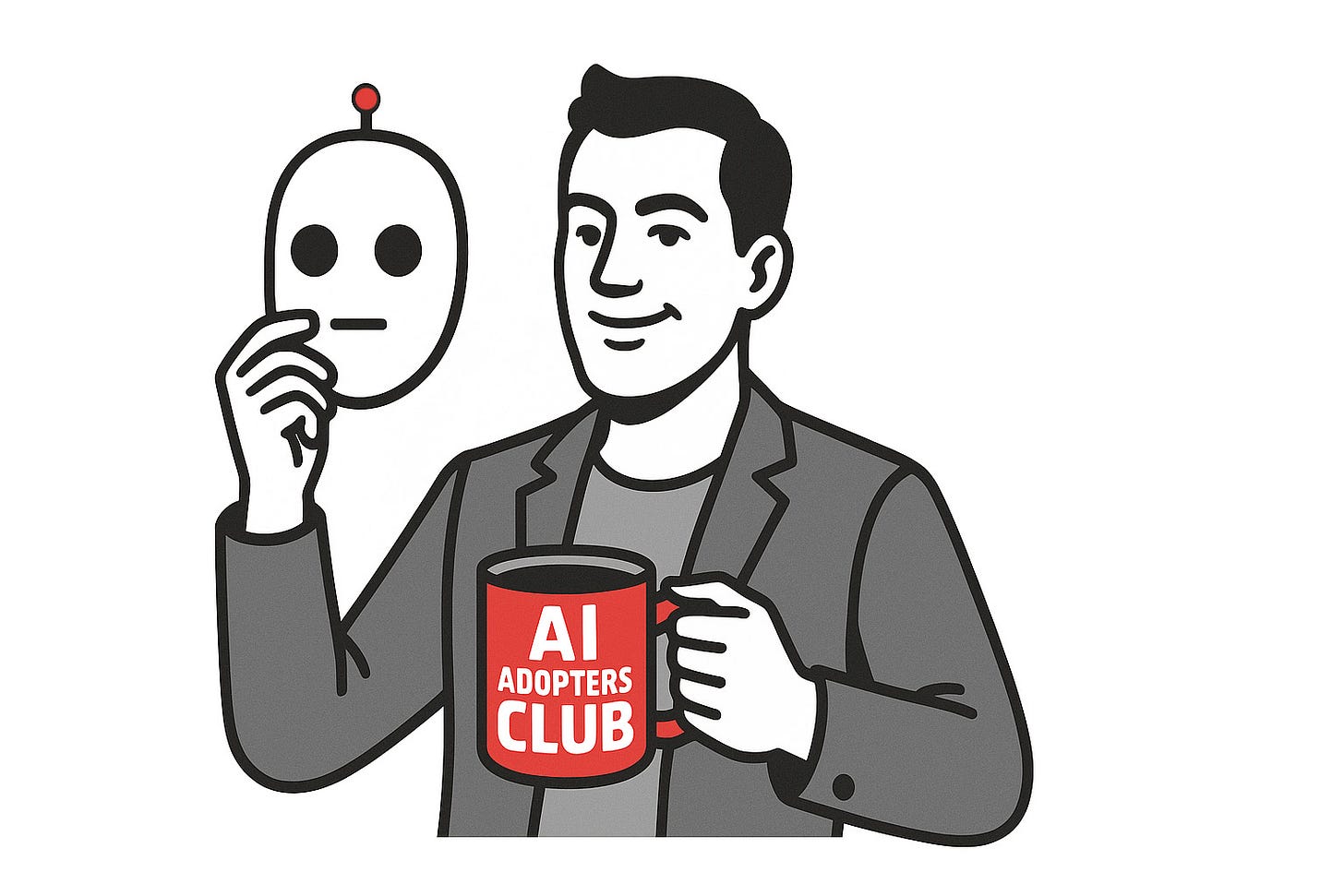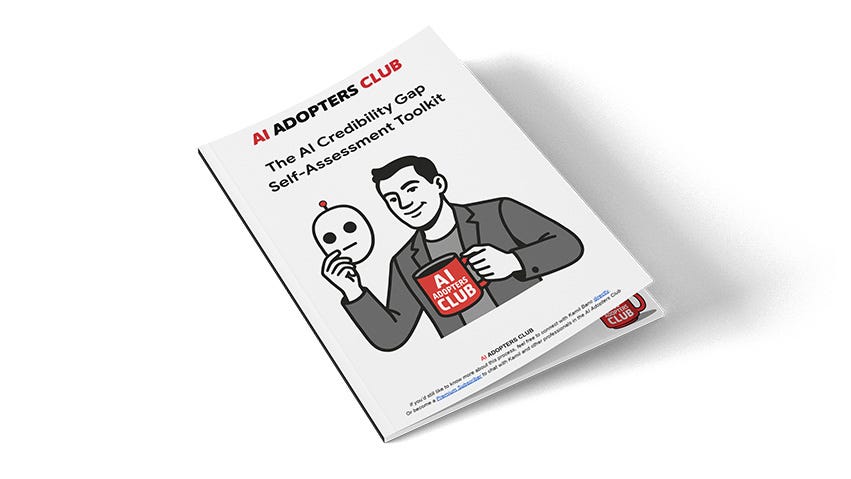You Are Not An AI Expert (Self-Assessment Included)
Why strategic honesty about limitations beats fake expertise every time
Hey Adopter,
The person who admitted they were "still figuring out AI workflows" just landed the biggest opportunity of their career. The one claiming to be an "AI transformation expert" is still waiting for callbacks.
Counter-intuitive? Absolutely. But research across 173 industry professionals reveals a fundamental shift: people now prefer working with honest learners over fake experts.
Here's what most AI adopters get wrong. They think credibility comes from knowing everything about artificial intelligence. In reality, it comes from knowing exactly what you know, what you don't, and being strategically transparent about both.
Today I'm sharing the AI Credibility Gap Method. It's a three-level framework that transforms your knowledge limitations into competitive advantages, whether you're building internal influence or external authority.
The Problem Everyone's Too Proud to Admit
Let's start with an uncomfortable truth that applies whether you're leading AI initiatives internally or guiding others externally.
An estimated 70% of people experience imposter syndrome, and in AI adoption, that number is probably higher. The field moves too fast. Research papers publish faster than anyone can read. Technologies evolve monthly.
Yet somehow, we're all supposed to project complete confidence about prompt engineering, model selection, workflow automation, and strategic implementation.
This creates what I call the AI Credibility Gap: the space between what you actually know about AI and what you think others expect you to know.
This gap shows up when:
Leadership asks about implementing AI in your organization
Colleagues look to you for AI guidance and strategic direction
You're competing against people who sound more AI-confident
Stakeholders want comprehensive AI transformation strategies
You need to scope AI projects without a full technical understanding
People expect you to have answers about AI capabilities beyond your current expertise
Most people try to close this gap by learning more, faster, or by cleverly avoiding topics where their knowledge runs thin. Both approaches miss the real opportunity.
The Unexpected Truth About AI Authority
Here's where conventional wisdom falls apart.
Studies on authentic leadership reveal that vulnerability, "when handled correctly, is a sign of strength". The research shows that 87% of people now consider trust more important than technical prowess alone.
Even more compelling, organizations that build trust bonds report an average 25% increase in engagement and outcomes. Not from knowing more, but from being more trustworthy about what they actually know.
The person who honestly says "I've tested three AI tools for this use case and here's what worked" gets more trust than the one who name-drops every AI trend. The advisor who clearly states their AI capabilities and limitations closes more opportunities than the one claiming universal AI expertise.
This is the foundation of the AI Credibility Gap Method.
The Three-Level Implementation Framework
The AI Credibility Gap Method works through three progressive levels, each building on the previous. Rather than overwhelming you with theory, I've created a complete self-assessment toolkit you can download and implement immediately.
Level 1: Gap Inventory Tools - Honest competency assessment using the AI Competency Matrix and Strategic Honesty Framework. Most people skip this because it feels vulnerable. That's exactly why it works.
Level 2: Vulnerability as Competitive Advantage - Communication templates that transform limitations into differentiation through what researchers call "intellectual candour". This creates business psychology research calls "reciprocal vulnerability" that strengthens professional relationships.
Level 3: Learning Transparency as Differentiation - Documentation methods for sharing your learning process. This seems risky but creates massive differentiation. Case studies show that learning transparency creates "inspiring experiences for others" while demonstrating rigorous methodology.
Download: The AI Credibility Gap Self-Assessment Toolkit
The complete framework includes:
AI Competency Matrix with rating system
Strategic Honesty Framework templates
Capability Communication scripts for high-stakes conversations
Credibility Calibration Questions Checklist
AI Experiment Documentation templates
Intelligent Learning - Share examples
This isn't just another framework to read about. It's a working toolkit designed for immediate implementation. Complete the self-assessment, apply the communication templates, and start building credibility through strategic transparency.
The Real-World Impact
This isn't just relationship advice. The economic and career benefits are measurable.
Deloitte research shows that high-trust professional relationships generate 88% more repeat collaboration. This translates to more high-impact projects, leadership visibility, referrals, and advancement opportunities.
Companies demonstrating strategic transparency see real results. Buffer's radical transparency approach increased applications by 200%, while Patagonia's honest communication about limitations achieved 73% customer loyalty.
The AI market is projected to reach $58.19 billion by 2034. Whether you're building internal AI capabilities or external AI influence, credibility differentiation isn't optional anymore.
The One-Switch Strategy
Andrew Ng advocates switching either roles OR industries, but not both simultaneously. The same principle applies to AI credibility building.
Don't try to master every AI tool while simultaneously positioning as a strategic AI leader. Pick either deep tool expertise OR strategic AI thinking first. The AI Credibility Gap Method works because it embraces this focused approach while being transparent about boundaries.
Ready, Fire, Aim for AI Leadership
You don't need to perfect this method before starting. Pick one tool this week:
Level 1: Complete the AI Competency Matrix assessment
Level 2: Use strategic honesty in one important AI conversation
Level 3: Document and share one AI learning experiment
The goal isn't to become an AI expert overnight. The goal is to become the person others trust most for AI guidance because you're honest about what you know, transparent about what you're learning, and clear about when to bring in specialists.
Your Implementation Plan:
Assess your current AI capabilities using the Competency Matrix
Develop your Strategic Honesty Framework for your top strength area
Test vulnerability positioning in one high-stakes conversation this week
Document one AI experiment and share the results with your network
The people building sustainable AI influence aren't the ones claiming universal AI knowledge. They're the ones building trust through strategic transparency.
In a world full of AI hype, honesty is the ultimate differentiator. Whether you're leading AI adoption internally or building external AI authority, the same truth applies: people follow those they trust, not those who pretend to know everything.
The AI Credibility Gap Method gives you the framework to turn your knowledge limitations into your most substantial competitive advantage.
Adapt & Create,
Kamil






This is amazing. And here's a suggestion for everyone... take the PDF, drop it into o3, and ask it to analyze the document and run a wizard--one question at a time--that will walk you though the process. Fantastic results...
By all account you practice what you preach. I appreciate this approach. You're not trying to cram your expertise or experience down our collective throat's.
Thank you